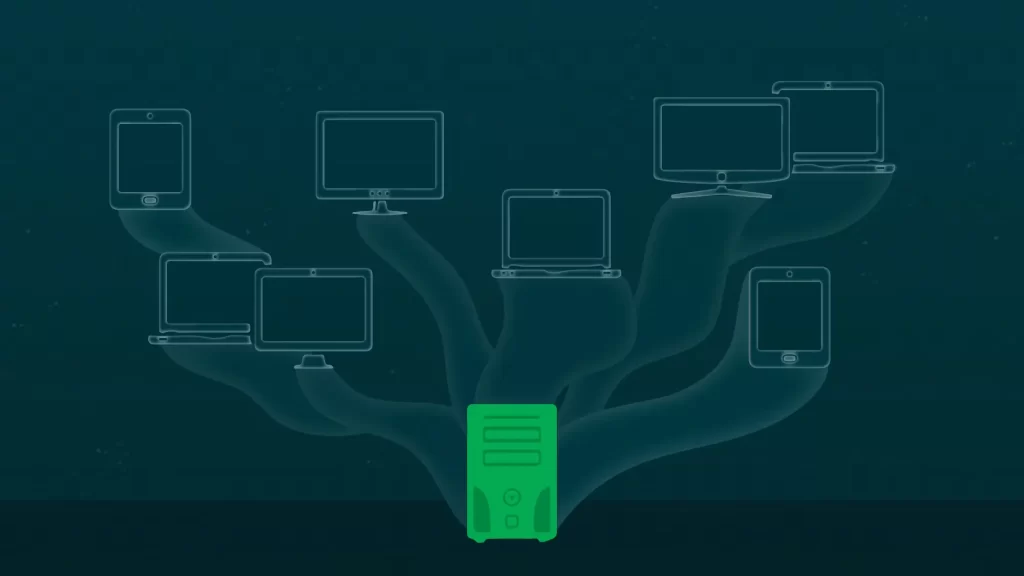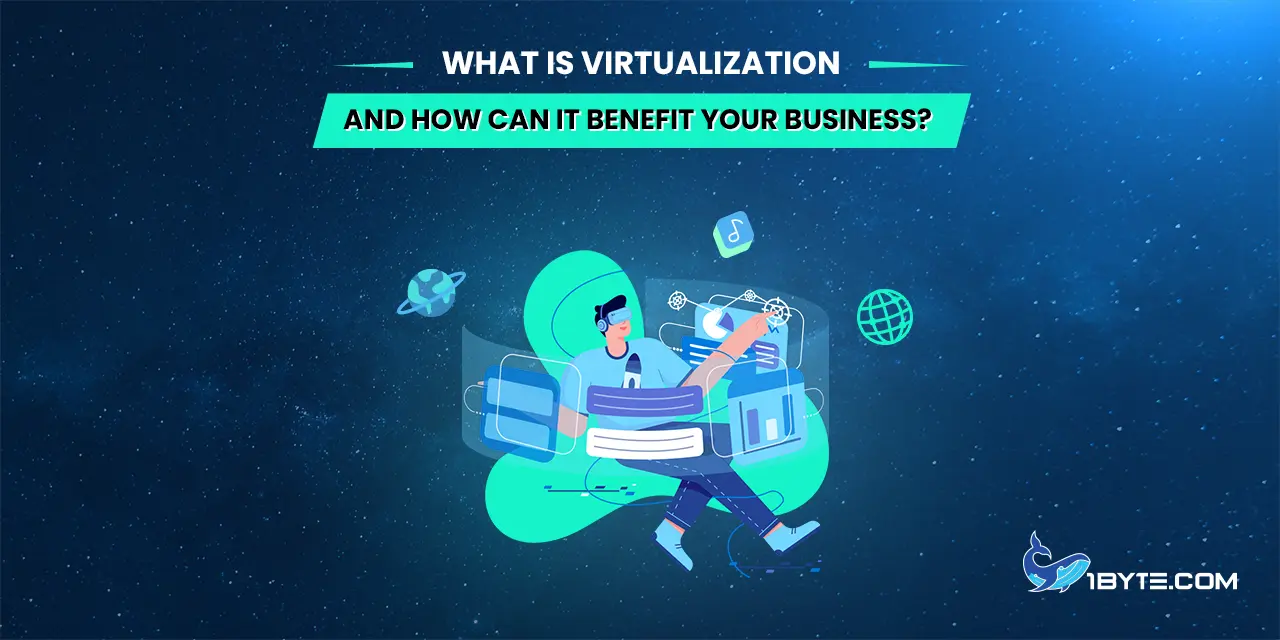Welcome to the virtualized world! In this post, we’ll look at the intriguing notion of virtualization and how it might help your organization. So, what is virtualization? Simply put, virtualization is a game-changing technology that enables you to unlock the full potential of your IT system.
Virtualization has the ability to transform any business, whether it is a small startup or a major corporation. It enables you to streamline operations, boost productivity, and fully utilize your IT infrastructure.
In the following sections, we’ll go deeper into the various types of virtualization, investigate their individual benefits, and offer practical advice on how to use virtualization to boost your business’s success. So strap on and prepare to unleash the transformative potential of virtualization!
What is Virtualization?
In this section of our post, we’ll debunk the concept of virtualization and explain its significance in business transformation.
What is virtualization and its core concept?
Virtualization is a game-changing technology that has transformed the information technology industry. Virtualization, at its heart, entails generating virtual replicas of physical resources such as servers, storage devices, or networks. These virtual resources are simple to manage, allocate, and use independently, giving firms flexibility and efficiency.
The abstraction of physical resources is the core idea underpinning virtualization. Virtualization, rather than depending on a one-to-one mapping between software and hardware, allows numerous virtual machines or environments to run on a single physical server. Each virtual machine runs independently, with its own operating system and programs, just like a dedicated physical machine.
A software layer known as a hypervisor enables this abstraction. The hypervisor serves as a bridge between real hardware and virtual machines, controlling resource allocation, ensuring isolation, and facilitating communication between virtual machines and underlying hardware.
The capacity to maximize resource consumption is one of the primary benefits of virtualization. Businesses can make greater use of their hardware by combining several virtual machines on a single physical server, lowering costs and increasing efficiency. Virtualization also allows for the rapid provisioning and deployment of virtual machines, allowing enterprises to rapidly grow their infrastructure and respond to changing demands.
The concept of snapshots and virtual machine migration is also significant in virtualization. Businesses can use snapshots to capture the status of a virtual machine at a specific point in time, making it easy to revert to a previous state if necessary. In contrast, virtual machine migration allows for the seamless movement of virtual machines between physical servers, ensuring high availability and facilitating workload balancing.
Virtualization in 2023
In 2023, virtualization will continue to gain traction, with various forms of virtualization being widely utilized by organizations. According to Statista, the global server virtualization market is expected to reach a whopping $10 billion by 2026, indicating the growing importance of this technology.
Storage virtualization leads the way among developing virtualization technologies, with a 40% adoption rate, according to Spiceworks. This technology, also known as software-defined storage, enables enterprises to more efficiently abstract and control their storage resources. Application virtualization, which has a 39% adoption rate, is close behind. Businesses can use application virtualization to insulate applications from the underlying operating system, improving compatibility and simplifying software deployment.

Another notable rival in the virtualization field is virtual desktop infrastructure (VDI) technology, which has a 32% adoption rate. VDI enables enterprises to host virtual desktops on centralized servers, allowing users to access their desktop environments remotely. This technology provides advantages such as increased security, easier desktop management, and increased mobility for distant workers.
Given these figures, it is clear that virtualization is a dynamic and expanding area that provides several benefits to enterprises. Virtualization will continue to play an important role in optimizing IT infrastructure and enabling digital transformation as technology progresses and businesses aspire for greater efficiency and flexibility.
Recommended reading: Data Center Virtualization: Streamlining Operations and Reducing Costs
5 Different Types of Virtualization
There is no such thing as a one-size-fits-all strategy to virtualization. There are various types of virtualization, each providing a different function and catering to different areas of IT architecture. Businesses may better leverage the power of virtualization to optimize their operations by understanding these varied forms.
Desktop Virtualization
Desktop virtualization is a strong technology that is transforming how enterprises distribute and manage end-user computing. It provides several advantages, ranging from more flexibility to increased security. Let’s take a look at desktop virtualization and see how it might help your organization.
Desktop virtualization, at its heart, entails building virtual desktop environments that are hosted on centralized servers. These virtual desktops operate independently, allowing users to access their customized desktop settings from any device with an internet connection.
Flexibility is one of the primary benefits of desktop virtualization. Users can access their virtual desktops from a variety of devices, such as laptops, tablets, and thin clients. This adaptability enables remote work, supports BYOD policies, and promotes collaboration among geographically distributed teams.
Another significant advantage is centralized management. IT administrators can monitor and maintain all virtual desktops from a centralized place using desktop virtualization. This makes processes like software upgrades, security patches, and user provisioning easier. It also allows IT companies to optimize desktop installations and save time and effort managing individual physical computers.
In general, desktop virtualization enables enterprises to provide their users with flexible, secure, and centrally controlled desktop environments. Desktop virtualization has become a game-changer for enterprises of all kinds, helping them to adapt to the developing digital landscape and boost productivity and efficiency. Its benefits include mobility, centralized management, enhanced security, disaster recovery, and cost savings.
Application Virtualization
Application virtualization is a cutting-edge technology that is transforming how firms deploy and manage software applications. It provides several advantages, ranging from increased flexibility to simplified application management. Let’s take a look at application virtualization and see how it might help your organization.
Application virtualization, at its most basic, is isolating software applications from the underlying operating system and enclosing them in self-contained virtual environments. These virtualized apps can then be distributed and executed on a variety of devices and operating systems without requiring traditional installation procedures.
Application virtualization enables enterprises to provide their users with flexible, centrally managed, and secure software applications. Application virtualization, with its benefits of flexibility, centralized management, increased security, and cost savings, provides a streamlined method to application deployment and management. It enables businesses to adapt to shifting technological landscapes, increase efficiency, and produce apps that propel their operations forward.
Server Virtualization
In the world of IT infrastructure, server virtualization is a game changer. It enables enterprises to make the best use of their physical server resources by hosting several virtual servers on a single physical server. Let’s look at server virtualization and how it can help your company.
In a nutshell, server virtualization allows for the development of virtual machines (VMs) that act as independent servers. These VMs each have their own operating systems, applications, and resources, but they all share the hardware of the underlying physical server. This server consolidation assists enterprises in optimizing their server architecture, lowering hardware expenses, and improving operational efficiency.
Server virtualization allows enterprises to manage their IT infrastructure in a cost-effective, scalable, and flexible manner. Server virtualization enables businesses to streamline their operations, cut costs, and adapt to the ever-changing technological landscape by maximizing resource consumption, improving scalability, simplifying management, and enhancing high availability and disaster recovery capabilities.
Storage Virtualization
Storage virtualization is an important component of virtualization since it increases the efficiency and flexibility of your data storage infrastructure. In this section, we’ll look at what storage virtualization is and how it can help your company.
Storage virtualization, in a nutshell, is the process of abstracting physical storage resources and presenting them as logical storage units for usage by virtual machines or applications. It enables enterprises to more effectively consolidate and manage their storage resources, regardless of the underlying storage technology.

Storage virtualization provides various advantages to enterprises, including increased storage efficiency, scalability, simplified management, greater data security, and access to innovative storage technology. Businesses can improve their storage infrastructure, cut expenses, and better match storage resources with business demands by virtualizing storage resources. It’s an effective tool for companies trying to streamline their storage operations and get the most out of their storage expenditures.
Network Virtualization
Network virtualization is a critical component of virtualization since it adds flexibility and efficiency to your network architecture. In this section, we’ll look at what network virtualization is and how it can help your company.
The process of building virtual networks that run independently of the underlying physical network infrastructure is known as network virtualization. It allows enterprises to abstract and combine network resources such as switches, routers, and firewalls to build virtual networks that may be tailored to individual requirements.
Businesses can benefit from network virtualization in a variety of ways, including improved network resource usage, increased agility, increased security, easier management, and the ability to establish secure connections across scattered environments. Businesses can optimize their network operations, decrease expenses, and acquire better flexibility in fulfilling their networking needs by virtualizing their network infrastructure. It is a crucial technology that enables firms to fully utilize their network resources and drive corporate success.
Recommended reading: Server Virtualization: Benefits and Best Practices
3 Challenges and Considerations
When considering virtualization for your company, it is critical to understand the problems and implications that come with this disruptive technology. While virtualization has many advantages, it also has some complications that must be addressed. Understanding these obstacles and making informed judgments can aid in the successful adoption of virtualization. Let’s look at some crucial issues to bear in mind as you begin your virtualization adventure.
Security concerns and ensuring compliance
Unauthorized access to virtual machines (VMs) or hypervisors is one of the key security problems in virtualized settings. You can reduce the likelihood of unauthorized individuals obtaining access to important resources by adopting strong access restrictions and authentication techniques, such as strong passwords and multi-factor authentication.
Furthermore, data breaches and data leaks are serious dangers in virtualized environments. It is critical to implement strong data encryption methods to secure data at rest and in transit. To protect sensitive information from prospective attackers, encryption mechanisms and secure communication channels should be created.
Additionally, virtualization environments should be patched and updated on a regular basis to address any vulnerabilities or weaknesses that may occur. This comprises not just the hypervisor software, but also the virtual machines and other virtualized infrastructure components. Updating all software ensures that any security patches or fixes are applied as soon as possible.
Another key factor to consider is maintaining compliance with applicable rules and industry standards. You may need to follow certain compliance frameworks, such as GDPR or HIPAA, depending on your organization and the sort of data you handle. It is critical to evaluate how virtualization affects compliance requirements and to put suitable safeguards in place to meet those obligations. This could include data privacy safeguards, audit logging, and regular security audits.
Organizations should also build comprehensive monitoring and logging tools to improve security and compliance in virtualized environments. This enables the detection of any suspicious actions or illegal access attempts, allowing for a rapid response and mitigation of possible security incidents.
Finally, employee awareness and training are critical in ensuring a secure virtualization environment. Educating your employees on best practices, security regulations, and potential risks can aid in the prevention of accidental security breaches and enhance overall security posture.
Staff training and skill development for managing virtualized environments
Staff training and skill development are critical for properly managing virtualized systems. As virtualization continues to disrupt the IT landscape, businesses must provide their IT staff with the knowledge and expertise required to handle this transformative technology.
To begin, comprehensive training on virtualization concepts is required. IT personnel should be well-versed in fundamental virtualization concepts such as hypervisors, virtual machines, and virtual networks. This foundation enables them to manage and troubleshoot virtualized environments successfully.
IT workers should obtain training on specific virtualization platforms and tools relevant to their firm, in addition to comprehending the underlying ideas. It is critical to be familiar with the features, functionalities, and administration capabilities of the chosen platform, whether it is VMware, Hyper-V, or another.
Furthermore, IT professionals should learn about resource management, capacity planning, and performance optimization in virtualized settings. This includes understanding how to properly distribute resources, monitor system performance, and detect and address any performance bottlenecks.
Security training is also extremely important. IT staff should be knowledgeable about applying security measures and best practices in virtualized systems. This includes instruction on securing virtual machines, configuring network security, implementing access restrictions, and securely managing virtualized storage.
Because virtualization is always growing, continued learning and skill growth are important. IT personnel should be encouraged to acquire certifications, attend training programs, and attend industry conferences in order to stay current on the newest breakthroughs in virtualization technology.
Promoting a culture of information sharing and collaboration among IT workers can considerably enhance virtualized environment management. Encouraging team members to share their experiences, difficulties, and solutions contributes to the development of a collective knowledge base and improves the team’s overall competence.
Monitoring and performance optimization in virtualized setups
Monitoring and performance improvement are also critical components of virtualized setup management. Because virtualization is dynamic, it is critical to closely monitor the performance of virtual machines, virtual networks, and storage resources to guarantee optimal system operation.

Proactive monitoring identifies possible faults and bottlenecks before they effect virtualized environment performance. IT teams may track resource use, system health, and network traffic patterns in real time by utilizing monitoring technologies.
Real-time monitoring allows for the rapid detection of performance issues such as excessive CPU or memory utilization, network congestion, or storage slowness. IT teams may prevent performance deterioration and ensure smooth operations by detecting and addressing these issues as soon as they arise.
Aside from real-time monitoring, historical performance data analysis can help detect trends and patterns. IT teams can acquire insights into usage patterns, peak workload periods, and resource requirements by reviewing historical data. This data can be used to influence capacity planning and resource allocation decisions.
Another key part of managing virtualized systems is performance improvement. IT teams may assure optimal performance and resource utilization by fine-tuning resource allocation. Adjusting CPU, memory, and storage allocations based on workload demands is part of this.
Virtualization platforms frequently provide advanced performance optimization capabilities such as dynamic resource allocation, load balancing, and intelligent task distribution. IT teams should become acquainted with these aspects and use them to improve performance.
Regular performance evaluations and benchmarking also aid in determining the success of virtualized environments. IT teams can discover areas for improvement and confirm the impact of optimization efforts by conducting frequent performance testing.
FURTHER READING: |
1.Cloud Migration Strategy: A Step-by-Step Guide |
2.Understanding Cloud Infrastructure: The Basics |
3. Public Cloud vs Private Cloud: Which One Should You Choose? |
Leverage 1Byte’s strong cloud computing expertise to boost your business in a big way
1Byte provides complete domain registration services that include dedicated support staff, educated customer care, reasonable costs, as well as a domain price search tool.
Elevate your online security with 1Byte's SSL Service. Unparalleled protection, seamless integration, and peace of mind for your digital journey.
No matter the cloud server package you pick, you can rely on 1Byte for dependability, privacy, security, and a stress-free experience that is essential for successful businesses.
Choosing us as your shared hosting provider allows you to get excellent value for your money while enjoying the same level of quality and functionality as more expensive options.
Through highly flexible programs, 1Byte's cutting-edge cloud hosting gives great solutions to small and medium-sized businesses faster, more securely, and at reduced costs.
Stay ahead of the competition with 1Byte's innovative WordPress hosting services. Our feature-rich plans and unmatched reliability ensure your website stands out and delivers an unforgettable user experience.
As an official AWS Partner, one of our primary responsibilities is to assist businesses in modernizing their operations and make the most of their journeys to the cloud with AWS.
Conclusion
For businesses looking to optimize their IT infrastructure, boost productivity, and drive innovation, virtualization has enormous promise. Businesses can obtain a competitive advantage in today’s dynamic digital landscape by grasping the concept of virtualization and its different applications. Adopting virtualization can pave the way for a more flexible, scalable, and cost-effective IT infrastructure, thereby setting firms for future success.

